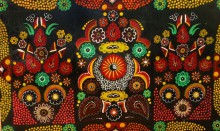The dwellers of this city (until recently Dniprodzerzhynsk) have famed neighbors, masters of Petrykivka painting, recognized by the UNESCO as part of humanity’s intangible cultural heritage. Their unsurpassed mastery of decorative painting keeps evoking amazement across the world.
The city of Kamianske was recently formally presented inside the Verkhovna Rada building. The event was titled “City with a soul.” A part of the exposition was made up by works of students of the Pershudchev School: drawings with a patriotic theme and unique paintings. One of the organizers of the exhibit, deputy principal Viacheslav Abramov told of the village of Mykolaivka near Novomoskovsk in Dnipropetrovsk oblast. Some three centuries ago a peculiar painting technique was born in this village. It was used to decorate furniture and dishes, but most often to finish off wooden chests of the local make.
Mykolaivka painting, which sank into oblivion in the Soviet time, got a second lease on life thanks to the efforts of experts in local history. Its basics are also taught to the students of the Kamianske Art School, led by experienced teacher Viktor Samovar, who has for a long time studied the ornamental principles of traditional Ukrainian painting. The material assembled over the years served as the basis for his book Dzherela pamiati (“Sources of Memory”), published as a textbook for art schools.
“We have offered the graduation works by the students from my class,” says Samovar. “These are full-scale sketches of Mykolaivka paintings of the facade and flanks of a chest, executed by Kateryna Horiainova, Yelyzaveta Yakymenko, Daria Yalova, and Oleksandr Danylchenko. It is great that the children respect our traditions and thoroughly perform quite complicated tasks.”
Samovar shares the niceties of Mykolaivka paintings with his students during composition classes. The basic principle is the study of elements of drawing (flowers and grapes) and their symmetric arrangement without using stencils. For the facade, a sheet of paper is divided into three vertical parts. This division, probably the key feature of this technique, symbolizes worshipping ancient god Rod and patrons of the home and hearth, deities represented by a mother and daughter. The composition of the drawing suggests the tree of life, a plant in a pot, which are often to be seen on embroideries, Easter eggs, and other artifacts of ethnic culture. According to Samovar, the subdued color scheme typical of Mykolaivka paintings resembles the traditional picture of a Cossack playing the bandura, or Cossack Mamai, where shades of ocher, brown, and terracotta dominate. The dark background, usually green, symbolizes nature and creates esthetic harmony in combination with the painting. Such a color scheme must stem from painted chests which had to be inconspicuously decorative elements of the interior. Chests where not only meant to contain clothes and other household items, they rather had a universal character, being placed in the most honorable place in the room, under the icons, and were used as tables or benches.
Modern furniture rendered old things unnecessary, and thus they no longer had to be painted. Grandmother’s chests were confined to barns and sheds and filled with grain or all manner of rubbish. Unfortunately, not many chests decorated with Mykolaivka painting have been found in Dnipropetrovsk oblast. Maybe, further search will produce positive results.
One pleasant event in Samovar’s life could be considered a rare stroke of luck or the fate’s reward for his love of national traditions: he received a commission to restore a Mykolaivka painted chest. First he made sure the painting corresponds to the canons of this technique, then looked into the degree to which the surface was damaged – and understood that it would be a crime to paint over the unique work of some old master. The inside of the lid bore the date of manufacture, May 1915. The chest is executed in a manner typical of that time: made of lime-tree planks and smeared with wood glue, which (when still wet) was covered with deep green powdered pigment to create the background for the painting. The colors contain egg yolk; for additional resistance, the painting was varnished with boiled drying-oil. Nowadays this chest is a specimen of Mykolaiv painting at the arts school in Kamianske.







